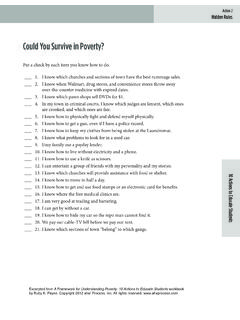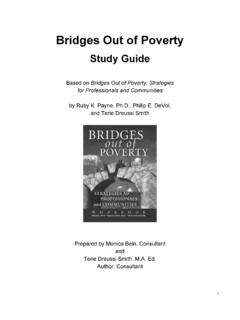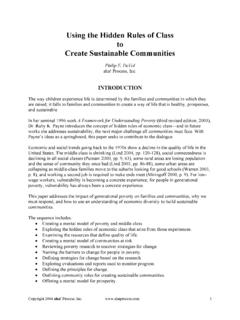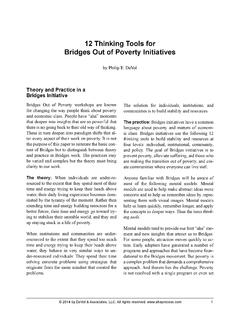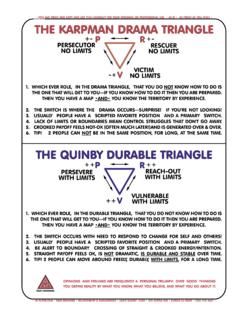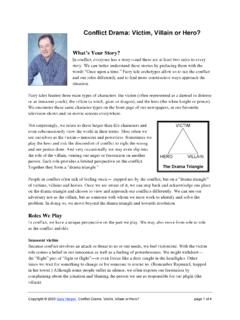Transcription of Continuing the conversation with long time members of the ...
1 DeVol, Page 1 Continuing the conversation with long time members of the Bridges Community of 2 Enhancing the Creativity of the Bridges Community of Practice Utilizing Stephen Karpman s drama Triangle and David Emerald s Empowerment Triangle by Philip E. DeVol In Part 1 I wrote about the two things that attract people to the Bridges work: new information that brings about a paradigm shift and a methodology that encourages people to innovate. The sharing of best practices led naturally to the development of a Community of Practice Model that generated new approaches, products, and programs. In this paper I will address how we can continue building the Bridges movement in a healthy way consistent with Bridges constructs.
2 I suppose this is another way of saying that there have been some hiccups along the way. Bridges communities intentionally do these four things: they bring people together from poverty, middle class, and wealth; they engage all sectors and disciplines; they encourage private/public partnerships; and they attract people from all political persuasions. What could possibly go wrong with relationships in that environment? Oh, in addition, we formed a Community of Practice that is by definition organic, messy, and unorganized. We would be saints if at times we had not felt like victims , rescuers , and persecutors . These are the three roles that Stephen Karpman described in the drama Triangle in 1968. (See the following diagram.)
3 Since then his ideas have been enhanced by a number of writers and applied in various disciplines. For example, I found the alcoholic family model very helpful while I was working in the addiction field. Source: These roles play themselves out as exaggerations of normal behaviors. After all, it is normal to rescue someone in an emergency and there are times when we are victims of events, circumstances, or people. And sometimes we need to be told to change direction. When people from different classes come together, whether it s in the agency setting or when GA grads meet their middle class supporters, the stage is set for the drama Triangle. All it takes to put the drama in motion is for one person to take on the rescuer role, another to become the victim, and a third to be the persecutor.
4 DeVol, Page 2 The drama arises when the rescuer has a motive or agenda that benefits him or herself. The rescuer appears to make great efforts to solve the problem but actually has a hidden motive to not succeed. The payoff for the rescuer may be enhanced self-esteem, maintaining rank over the person who is being rescued, or the rescuer may enjoy having someone dependent upon them. The victim and persecutor also have unconscious and selfish needs being met. There is a payoff for them too. As the drama unfolds people switch roles. For example, the persecutor may become the victim because their help was not appreciated or used. The victim, who thinks that he or she hasn t been served properly, can become the persecutor.
5 In this dysfunctional system people feed on the excitement of the drama . The drama Triangle creates confusion and inauthentic relationships. Bridges and GA sites are fertile ground for the drama Triangle because, as mentioned above, we bring so many people into the work from so many directions. Inherent in class and organizational structures is rank and rankism, which adds a special toxicity to the formula. Despite the inoculation against rankism found in the core constructs of Bridges, middle class people are likely to see themselves as rescuers and the GA grads to see themselves as victims. That, I suppose, is the effect of classism. It is easy to see how middle class allies may become rescuers, then persecutors, and then victims.
6 Allies may see the GA grad as the problem or the project and themselves, with all their connections and resources, as the ones with the answers. Pushing for achievement of the SMART plan and not getting the results or the gratitude that they expect may slip them into the persecutor or victim role. The GA grad can switch roles too. The GA grad, feeling disrespected, may change from the victim to the persecutor. Add others members of the Bridges initiative to this and you have enough players to fill the role of the so it goes. In short, the drama Triangle is a victim orientation that feeds on fear, survival, control, distrust, manipulation, blame, and ends in the death of relationships. Need I point out that this drama can occur within the Bridges Community of Practice?
7 Speaking for myself I can tell you that I have played these roles and have seen the drama triangle at work in our Community of Practice. That s a good thing because the typical prescription for dealing with the drama Triangle is to recognize when it occurs so that potential players can avoid being sucked into the drama . It gives us a language to decode stressful, unpredictable, relationship-based environments like poverty. It could be particularly helpful to GA grads when they are making intentional changes in their relationships both old and new. And it could be equally helpful to allies and service providers who want to help without pulling rank. Of course our Community of Practice would benefit by learning about the drama Triangle.
8 But the solution to somehow avoid it is not enough. That solution continues to focus on negative ways of thinking and behaving. No matter how much one wants to do better, all the terms are from the victim orientation. DeVol, Page 3 Escaping from the drama Triangle using the Empowerment Triangle: Source: How much better would it be to have a shift in paradigms so complete that the focus flips 180 degrees to the positive? David Emerald s Empowerment Triangle provides just what is needed. In his model there are three roles: Creator, Challenger, and Coach. It is significant that Stephen Karpman, the originator of the drama Triangle, is quoted on the cover of Emerald s book stating, The Empowerment Triangle is a highly original and effective escape from the drama Triangle.
9 The paradigm shift called for by Emerald is the same paradigm found in the methodology of Bridges and Getting Ahead. It starts with recognizing that Getting Ahead investigators are problem solvers and continues until people from all three classes are at the decision making table co-creating solutions together. Emerald says, The shift from Victim to Creator takes place by focusing on what we want rather than what we don t want, by moving from reacting to choosing outcomes and our responses from life experiences, and by reconnecting to our dreams and desires. Transforming our relationships with Persecutors so that we see them as Challengers instead calls upon us to discern the learning and growth they spark. To become a conscious Challenger in relationships with others requires clarity of intention, the ability to see the other as a Creator in their own right, and the wish to provoke and evoke growth and development.
10 The shift from Rescuer to Coach invites us to see the other as creative and resourceful, and to support him in the creation process by asking questions and facilitating his own clarification of envisioned outcomes, and the current realities he ( ) While the Empowerment Dynamic is played out by individuals, it can also apply within organizations and community collaboratives. The future story for our Community of Practice is going to be unfolding at a faster rate because of the growing number of Bridges sites. Advancing Bridges, Inc. the new non-profit organization is going to accelerate the innovation process and lift our work to the policy level. At this point in our history, we need a way of working with one another where we choose not to act as victims, rescuers, and persecutors but instead as creators, challengers and coaches.
